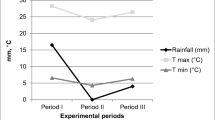Abstract
This study aimed to evaluate the hypothesis that mixed sequential grazing of dairy cows and breeding ewes is beneficial. During the seasons of spring–summer 2013 and autumn–winter 2013–2014, 12 (spring–summer) and 16 (autumn–winter) Holstein Friesian cows and 24 gestating (spring–summer) and lactating (autumn–winter) Pelibuey ewes grazed on six (spring–summer) and nine (autumn–winter) paddocks of alfalfa and orchard grass mixed pastures. The treatments “single species cow grazing” (CowG) and “mixed sequential grazing with ewes as followers of cows” (MixG) were evaluated, under a completely randomized design with two replicates per paddock. Herbage mass on offer (HO) and residual herbage mass (RH) were estimated by cutting samples. The estimate of herbage intake (HI) of cows was based on the use of internal and external markers; the apparent HI of ewes was calculated as the difference between HO (RH of cows) and RH. Even though HO was higher in CowG, the HI of cows was higher in MixG during spring–summer and similar in both treatments during autumn–winter, implying that in MixG the effects on the cows HI of higher alfalfa proportion and herbage accumulation rate evolving from lower residual herbage mass in the previous cycle counteracted that of a higher HO in CowG. The HI of ewes was sufficient to enable satisfactory performance as breeding ewes. Thus, the benefits of mixed sequential grazing arose from higher herbage accumulation, positive changes in botanical composition, and the achievement of sheep production without negative effects on the herbage intake of cows.
Similar content being viewed by others
References
Améndola, R., Castillo, E. and Martínez, P.A. 2006. Forage Resource Profiles. Mexico. FAO, Rome, Italy (http://www.fao.org/ag/agp/agpc/doc/counprof/PDF%20files/Mexico-English.pdf Accessed 09 May 2017).
Cosgrove, G.P. and Edwards, G.R. 2007. Control of grazing intake. In: Pasture and Supplements for Grazing Animals. Rattray, P.V., Brookes I.M., and Nicol, A.M. (Eds.). New Zealand Society of Animal Production, Occasional Publication No. 14. Hamilton, New Zealand, 61–80.
d’Alexis, S., Sauvant, D. and Boral, M. 2014. Mixed grazing systems of sheep and cattle to improve live weight gain: a quantitative review. Journal of Agricultural Science, 152, 655–666.
Dear, B.S., Virgona, J.M., Spandrel, G.A., Swan, A.D. and Orchard, B.A. 2007. Lucerne, phalaris and wallaby grass in short-term pasture phases in two Eastern Australian wheat belt environments. 1. Importance of initial perennial density on their persistence and recruitment, and on the presence of weeds. Australian Journal of Agricultural Research, 58, 113–121.
Fraser, M.D., Davies, D.A., Vale, J.E., Hirst, W.M. and Wright, I.A. 2007. Effects on animal performance and sward composition of mixed and sequential grazing of permanent pasture by cattle and sheep. Livestock Science, 110, 251–266.
Hernández Garay, A., Martínez Hernández, Pedro A., Zaragoza Esparza, J., Vaquera Huerta, H., Osnaya Gallardo, F., Joaquín Torres, B.M. and Velazco Zebadúa, M.E. 2012. Caracterización del rendimiento de forraje de una pradera de alfalfa-ovillo al variar la frecuencia e intensidad del pastoreo. Revista Fitotecnia Mexicana, 35, 259–266.
Isselstein, J., Griffith, B.A., Pradel, P. and Venerus, S. 2007. Effects of livestock breed and grazing intensity on biodiversity and production in grazing systems. 1. Nutritive value of herbage and livestock performance. Grass and Forage Science, 62, 145–158.
Jones, G.B., Alpuerto, J.B., Tracy, B.F. and Fukao, T. 2017. Physiological effect of cutting height and high temperature on regrowth vigor in orchard grass. Frontiers in Plant Science www.frontiersin.org, Volume 8, Article 805.
Nicol, A.M. and Brookes, I.M. 2007. The metabolisable energy requirements of grazing livestock. In: Pasture and Supplements for Grazing Animals. Rattray, P.V., Brookes I.M., and Nicol, A.M. (Eds.). New Zealand Society of Animal Production, Occasional Publication No. 14. Hamilton, New Zealand, 151–172.
Pérez-Prieto, L.A., Peyraud, J.L. and Delagarde, R. 2011. Substitution rate and milk yield response to corn silage supplementation of late-lactation dairy cows grazing low-mass pastures at 2 daily allowances in autumn. Journal of Dairy Science 94, 3592–3604.
Pérez-Prieto, L.A., Peyraud, J.L. and Delagarde, R. 2012. Does pre-grazing herbage mass really affect herbage intake and milk production of strip-grazing dairy cows? Grass and Forage Science, 68, 93–109.
Ramírez-Mella, M., Hernández-Mendo, O., Améndola-Massiotti, R.D., Ramírez-Bribiesca, E.J., Mendoza-Martínez, G.D. and Burgueño-Ferreira, J.A. 2010. Productive response of grazing dairy cows to fresh chopped maize supplementation under a small farming system in the Mexican Highlands. Tropical Animal Health and Production, 42, 1377–1383.
SAS (Statistical Analysis System). 2004. SAS/STAT 9.1 User’s Guide. SAS Publishing. Cary, North Carolina, USA.
Shen, Y., Jiang, H., Zhai, G. and Cai, Q. 2013. Effects of cutting height on shoot regrowth and forage yield of alfalfa (Medicago sativa L.) in a short-term cultivation system. Grassland Science, 59, 73–79.
Sollenberger, L., Coleman, S.W. and Vendramini, J.M.B. 2013. As interações entre plantas e herbívoros em pastagens. In: Forragicultura: Ciência, Tecnologia y Gestão dos Recursos Forrageiros. Reis, R.A.,Bernardes, T.F. and Siqueira, G.R. (Eds). Gráfica Multipress Jaboticabal SP. Brasil. pp: 69–76.
Villalba, J.J., Cabassu, R. and Gunter, S.A. 2015. Forage choice in pasturelands: Influence on cattle foraging behavior and performance. J. Anim. Sci., 93:1729–1740.
Wright, I.A., Jones, J.R. and Parsons, A.J. 2001. Effects of grazing by sheep or cattle on sward structure and subsequent performance of weaned lambs. Grass and Forage Science, 56, 138–150.
Author information
Authors and Affiliations
Corresponding author
Ethics declarations
Statement of animal rights
The study was carried out in accordance with guidelines of the Research Ethics Committee of the EU Directive 2010/63/EU for animal experiments.
Conflict of interest
The authors declare that they have no conflict of interest.
Rights and permissions
About this article
Cite this article
Jiménez-Rosales, J.D., Améndola-Massiotti, R.D., Burgueño-Ferreira, J.A. et al. Herbage intake of dairy cows in mixed sequential grazing with breeding ewes as followers. Trop Anim Health Prod 50, 531–536 (2018). https://doi.org/10.1007/s11250-017-1464-8
Received:
Accepted:
Published:
Issue Date:
DOI: https://doi.org/10.1007/s11250-017-1464-8




